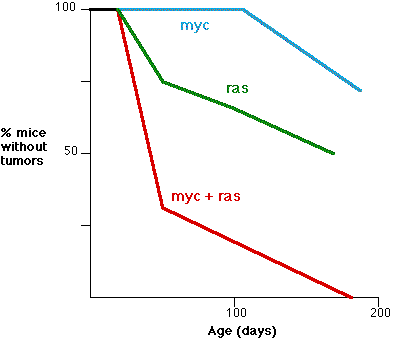An oncogene is a gene that
Cancer cells are cells that are engaged in uncontrolled mitosis.
Example: PDGF (platelet-derived growth factor), which is encoded by the gene PDGFB (also known as SIS).
Example: the protein encoded by the gene ERBB2 encodes a receptor for epidermal growth factor (EGF). (In humans, ERBB2 is also known as HER2.)
| Link to discussion. |
Many of these involve kinases — enzymes that attach phosphate groups to other proteins. Examples: the proteins encoded by SRC, RAF, ABL, and the fusion protein encoded by BCR/ABL found in chronic myelogenous leukemia (CML).
or
molecules that turn on kinases. Example: RAS, which activates RAF.
Examples: AP-1, a heterodimer of the proteins encoded by jun and fos.
Example: myc.
Example: the oncomouse: a transgenic mouse that has both copies of its myc gene under the influence of extra-powerful promoters.
All these oncogenes act as dominants; if the cell has one normal gene (sometimes called a proto-oncogene) at a locus and one mutated gene (the oncogene), the abnormal product takes control.
No single oncogene can, by itself, cause cancer. It can, however, increase the rate of mitosis of the cell in which it finds itself. Dividing cells are at increased risk of acquiring mutations, so a clone of actively dividing cells can yield subclones of cells with a second, third, etc. oncogene. When a clone loses all control over its mitosis it is well on its way to developing into a cancer.
| Link to a discussion of the number and types of genetic "errors" needed to produce a full-blown cancer. |

This graph (based on the work of E. Sinn et al, Cell 49:465,1987) shows the synergistic effect of two oncogenes. The fraction (%) of transgenic mice without tumors is shown as a function of age. Three groups are shown:
Mutations arise from an unrepaired error in DNA. So any gene whose product participates in DNA repair probably can also behave as an oncogene when mutated.
| Link to discussion of DNA repair. |
Example: ATM. ATM (="ataxia telangiectasia mutated") gets its name from a human disease of that name, whose patients — among other things — are at increased risk of cancer. The ATM protein is also involved in detecting DNA damage and interrupting the cell cycle when damage is found.
It is estimated that fully 1% of the 25,000 or so genes in the human genome are proto-oncogenes.
| Discussion of Tumor-Suppressor Genes |
| Welcome&Next Search |